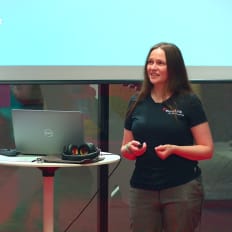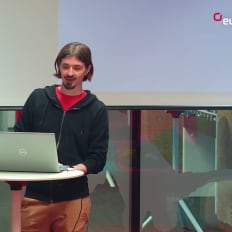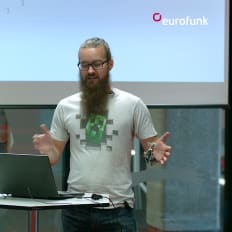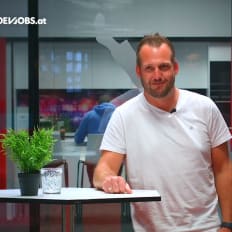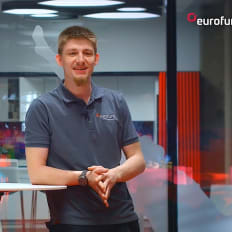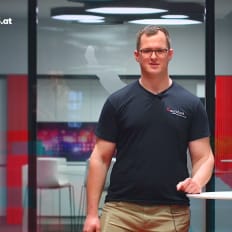
eurofunk Kappacher GmbH
Viktoria Haselsteiner, Scrum Master bei eurofunk Kappacher
Description
Viktoria Haselsteiner von eurofunk Kappacher spricht im Interview über ihren Einstieg in die Welt von Scrum, welche Fähigkeiten sie dabei als besonders hilfreich erlebt hat und worauf es ihrer Meinung nach in der täglichen Arbeit wirklich ankommt.
By playing the video, you agree to data transfer to YouTube and acknowledge the privacy policy.
Video Summary
In "Viktoria Haselsteiner, Scrum Master bei eurofunk Kappacher," speaker Viktoria Haselsteiner charts her path from first exposure to agile at university through UX design in agile teams to becoming a Scrum Master 1.5 years ago at eurofunk, where she coaches two teams within the C-Framework. Her teams build the EUX Suite for emergency control centers; she serves as facilitator and communication bridge, moderates meetings, removes impediments, and supports work in agile Release Trains. Driven by meaningful impact for people seeking emergency help, her key takeaways are to strengthen the agile mindset alongside any framework and to value the human side with empathy for diverse team dynamics.
From UX to Team Coach: Lessons from “Viktoria Haselsteiner, Scrum Master bei eurofunk Kappacher” on Agile Mindset, Facilitation, and Purpose in Product Development
Editorial perspective from DevJobs.at
In the session “Viktoria Haselsteiner, Scrum Master bei eurofunk Kappacher” (Speaker: Viktoria Haselsteiner, Company: eurofunk Kappacher GmbH), we hear a concise account of a career path that resonates across engineering teams: moving from UX design into the Scrum Master role—framed as a Team Coach—within a scaled development environment. The story is straightforward and grounded, yet it highlights precisely the levers that make agile teams succeed: a clear agile mindset, strong facilitation, and a deep motivation to build products with real-world impact.
Below we recap what we observed and learned, translating Viktoria Haselsteiner’s key points into practical takeaways for developers and tech practitioners—especially those curious about roles that blend coaching, moderation, and cross-team communication.
The starting point: studies, agile exposure, and proximity to software
Haselsteiner encountered agile methods and processes during her studies. She was already interested in software development, but her first professional steps led through UX design—working inside agile teams. That vantage point matters: UX sits at the junction of user needs, product intent, and engineering reality. In agile settings, it often means testing hypotheses quickly, guiding iterative decisions, and helping the team develop a shared understanding.
“I first came into contact with agile methods and processes at university … and started working as a UX designer in agile teams.”
From there, the move toward Scrum Master is natural for many: day by day you find yourself facilitating more, structuring conversations, bridging gaps in communication, and caring about the flow of collaboration as much as the artifact itself.
A deliberate pivot: from UX designer to Scrum Master
The turning point in Haselsteiner’s narrative is subtle but decisive: she slowly realized that the Scrum Master role genuinely interested her. Such transitions rarely happen overnight; they typically emerge as you lean into facilitation and begin to shape team routines more than design deliverables.
“I gradually noticed that I’m actually very interested in the Scrum Master role.”
About a year and a half ago, she reoriented and joined eurofunk Kappacher GmbH as a Scrum Master. That same timeframe—one and a half years—marks her current tenure, a period often defined by learning the team’s rhythms, establishing foundational practices, and refining a personal coaching stance.
Context and mission: two teams, a C-Framework, and agile Release Trains
Haselsteiner currently supports two teams at eurofunk. The teams are organized under a “C-Framework,” with “agile Release Trains” providing cadence and structure. Even without additional detail on the framework, the implications are clear: scaling across multiple teams, synchronized delivery, and a need for robust cross-team communication.
“Our teams are organized according to the C-Framework, and that’s why we also have agile Release Trains.”
In such environments, the Scrum Master as Team Coach takes on elevated importance: you’re not only facilitating inside a team but also connecting dots across teams, channels, and stakeholders.
Product and impact: the EUX Suite for emergency control centers
Her teams work on the “EUX Suite”—software used in emergency control centers. The system supports taking emergency calls and coordinating response units. Even this brief description speaks volumes about the constraints: time-critical decision-making, reliability under pressure, clarity of information, and seamless handovers.
“A software used in emergency control centers to receive emergency calls and then coordinate the deployment of resources.”
For a Team Coach, that translates into enabling stable, focused engineering: spotting impediments early, clarifying priorities, syncing with stakeholders, and keeping the product’s mission visible in day-to-day work.
Why this work: purpose, impact, and responsibility
Haselsteiner is explicit about her motivation: she wants her work to have impact. At eurofunk Kappacher GmbH, the systems directly help people who call for emergency assistance. The chain—call, coordination, fast response—creates a compelling purpose that sharpens product decisions and strengthens team alignment.
“It’s a job with meaning … with my work I help people who make emergency calls and need help as quickly as possible.”
She also notes that the system should help “me and everyone else” should we ever need assistance. That identification with the end outcome is powerful: it centers quality, clarity, and reliability not as abstract metrics but as human obligations.
Role clarity: Scrum Master as Team Coach
Within the C-Framework context she describes, the Scrum Master is known as the Team Coach—a label Haselsteiner finds fitting. She outlines three major dimensions of her day-to-day work:
- Coaching on processes, principles, and practices: enabling sustainable ways of working rather than directing tasks.
- Facilitation and moderation: coordinating meetings, designing the space for conversation, and guiding decisions.
- Building communication bridges: connecting with other teams, channels, and stakeholders, so dependencies are clear and information flows.
“I coordinate meetings, moderate, and am very strong as a facilitator … I serve as a communication bridge to other teams and stakeholders … and make sure the team can work well without impediments.”
These are universal skills, but they become mission-critical in scaled environments where release trains require consistent rhythm and cross-team trust.
The two sides of the role: agile mindset and human dynamics
Haselsteiner distills her perspective into two pillars:
1) Sharpen the agile mindset. Success hinges not on the framework you pick but on understanding why you’re working this way. Mindset before mechanics.
“You can use different frameworks, but without the mindset it’s hard.”
2) Lean into the human side. Team dynamics vary; every team is different. It takes empathy and active support to navigate those differences.
“Every team is different … you need a lot of empathy … the human part is very important.”
This duality—principles and people—describes the terrain of everyday team coaching. Structures enable; relationships sustain.
Practical takeaways for engineers and practitioners
Whether you’re aiming for a formal Scrum Master position or simply want to strengthen your team’s collaboration, Haselsteiner’s emphasis offers practical starting points.
1) Put mindset before framework
- Understand the “why”: Why short feedback loops? Why iterative delivery? Why transparency? Knowing this turns practices from checklists into levers.
- Treat frameworks as toolkits: Practices from Scrum, Kanban, or scaled setups are means, not ends. Use them to serve product and team context.
- Keep purpose visible: In moments of friction, reconnect to the mission—especially vital for products with real-world stakes.
2) Make facilitation a core skill
- Shape meetings deliberately: Clear purpose, clear agenda, clear timebox. Ensure everyone can contribute and decisions can be made.
- Grow moderation techniques: Ask questions, summarize, focus, visualize—and be comfortable with constructive silence.
- Enable decisions: Identify blockers, missing information, and necessary participants. Facilitation creates movement without dictating content.
3) Be a communication bridge
- Surface dependencies: Who relies on whom? What do we need from other teams—and what do they need from us?
- Engage stakeholders early: Align expectations, share updates, and make feedback actionable.
- Stabilize information flow: Regular touchpoints, clear channels, and documented decisions underpin reliable delivery.
4) Translate empathy into team practice
- Practice perspective-taking: Each role sees different risks and opportunities. Empathy helps turn conflict into a signal, not a stalemate.
- Leverage differences: Recognize strengths and integrate diverse working styles instead of flattening them.
- Foster safety: People raise issues when psychological safety is real. Good facilitation creates that space.
5) Remove impediments systematically
- Detect early: Listen, observe, and look for patterns. Make blockers visible.
- Clarify ownership: Who can resolve which impediment? Escalate when necessary—always transparently.
- Keep focus: Every removed impediment immediately boosts delivery capability and team experience.
The special context: building software for emergency control centers
Because the EUX Suite supports call intake and resource coordination in emergency centers, the product context magnifies certain priorities:
- Clarity and reliability: Under time pressure, software behavior must be predictable, and information must be dependable.
- Usability under stress: Interfaces and workflows must hold up when stakes are high and attention is strained.
- Cross-team collaboration: With multiple teams contributing, release trains and clean interfaces are not just process—they are preconditions for impact.
Haselsteiner’s focus on purpose and team support aligns with this context: enable smooth development, remove obstacles, and keep the product mission front and center.
A role that scales: Team Coach in release train environments
The “Team Coach” label fits because it sets clear expectations without imposing rigidity:
- Coach, not controller: The aim is enablement, not command.
- Team, not heroics: Collaboration—rather than individual brilliance—moves the product forward.
- Context, not silos: In release trains, the quality of handoffs is as crucial as the quality of code.
The result is a working mode where self-organization and reliability reinforce each other. Teams self-organize, and the Team Coach cultivates the conditions that make this possible.
A career compass: interest, experience, and impact
Haselsteiner’s path offers a three-point compass for anyone planning a next step:
- Take your interests seriously: Her early interest in software development provided direction—even when starting from UX design.
- Transfer adjacent skills: Facilitation, empathy, and user focus translate directly into the Scrum Master/Team Coach playbook.
- Let impact guide you: Joining eurofunk Kappacher GmbH ties to a purpose narrative—“a job with meaning.” Purpose clarifies priorities.
Quotes and insights that stick
“In the C-Framework, the Scrum Master is also called the Team Coach—and I find the title fitting.”
“I make sure the team gets the support it needs to develop.”
“You can use different frameworks, but without the mindset, it’s hard.”
“Every team is different … you need a lot of empathy … the human part matters.”
These lines sketch a working philosophy that creates stability without rigidity—keeping both people and product at the center and using process as a means, not an end.
Next steps for readers
If you want to turn these ideas into momentum, try small steps with outsized effect:
1) Map your mindset: Write down the principles that guide your work. Where are you acting “by process” versus “by purpose”? Note concrete examples.
2) Build a facilitation habit: Each week, deliberately design one meeting—goal, agenda, timebox, wrap-up. Experiment and reflect.
3) Be a bridge: Identify a current dependency with another team or stakeholder. Set up a clear check-in and document the decision.
4) Operationalize empathy: In your next retrospective, ask for needs, not just problems. What support would make the biggest difference?
5) Make impediments visible: Start a simple impediment board. Prioritize, bring it to the right forum, and track resolution to done.
Each step is small enough to start tomorrow and big enough to move the needle.
Closing: leading through stance, delivering through purpose
“Viktoria Haselsteiner, Scrum Master bei eurofunk Kappacher” shows how roles evolve through genuine interest, consistent practice, and a clear purpose. Working on the EUX Suite—software for emergency control centers where calls are taken and resources are coordinated—grounds the mission: helping people quickly and reliably when it matters most.
Framing the Scrum Master as a Team Coach—coaching, facilitating, bridging communication, and removing impediments—fits this mission well. Two pillars anchor the approach: an agile mindset and the human side of teamwork.
Our main takeaway: strong teamwork starts with stance, not ceremonies. And its maturity becomes visible where products carry real responsibility. Haselsteiner’s path underlines how these threads belong together—and how a career built on them can be meaningful, effective, and deeply human.
More Tech Talks
eurofunk Kappacher GmbH From Sound to Sense
Sabine Hasenleithner von eurofunk Kappacher spricht in ihrem devjobs.at TechTalk über die technischen Hintergründe von Sprach Erkennung im Notruf Kontext und zeigt in einer Live Demo eine mögliche Implementierung.
Watch noweurofunk Kappacher GmbH Effortless Versioning
Stefan Höller von eurofunk Kappacher zeigt in seinem devjobs.at TechTalk, wie das Unternehmen die Versionsverwaltung bei langen Produktzyklen mithilfe von Semantic Release gestaltet hat.
Watch noweurofunk Kappacher GmbH Cypress Component Tests
Patrick Pichler von eurofunk Kappacher demonstriert in seinem devjobs.at TechTalk die Herangehensweise des Teams, wie sie Component Tests mit cypress durchführen.
Watch noweurofunk Kappacher GmbH Application Load Testing with k6
Daniel Knittl-Frank von eurofunk Kappacher spricht in seinem devjobs.at TechTalk darüber, wie die hohen Performance Anforderungen der im Unternehmen entwickelten Software erfüllt werden.
Watch now
More Tech Lead Stories
eurofunk Kappacher GmbH Thomas Ronacher, Head of Technical Support bei eurofunk Kappacher
Thomas Ronacher von eurofunk Kappacher spricht im Interview über die Struktur des Teams, die verwendeten Technologien und wie der Bewerbungs- und Onboardingprozess abläuft.
Watch noweurofunk Kappacher GmbH Johanna Blum, Release Train Engineer bei eurofunk Kappacher
Johanna Blum von eurofunk Kappacher beleuchtet im Interview die Teamkultur, die wichtigsten Technologien im Einsatz und die Besonderheiten des Recruiting-Prozesses.
Watch now
More Dev Stories
eurofunk Kappacher GmbH Maximilian Spiesmaier, IT Security Consultant bei eurofunk Kappacher
Maximilian Spiesmaier von eurofunk Kappacher teilt im Interview seine Erfahrungen aus der IT Security, welche Herausforderungen er im Arbeitsalltag meistert und wie man am besten in den Beruf startet.
Watch noweurofunk Kappacher GmbH Valentin Zintl, Junior Development Engineer bei eurofunk Kappacher
Valentin Zintl von eurofunk Kappacher erzählt im Interview über seinen Karriereweg, welche Aufgaben ihn täglich erwarten und welche Fähigkeiten besonders für den Einstieg wichtig sind.
Watch noweurofunk Kappacher GmbH Johannes Festi, Trainee Software Development bei eurofunk Kappacher
Johannes Festi von eurofunk Kappacher gibt im Interview Einblicke in den Arbeitsalltag als Software Development Trainee, wie er dazu gekommen ist und was seiner Ansicht nach wichtig für den Einstieg ist.
Watch now

